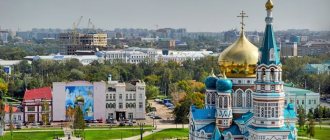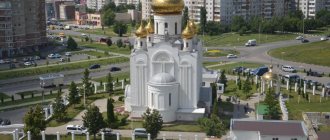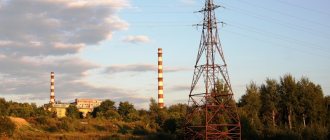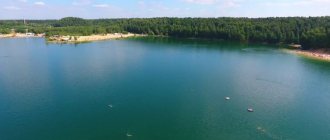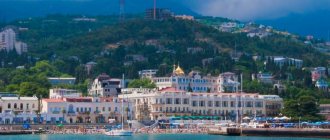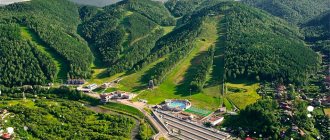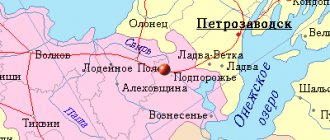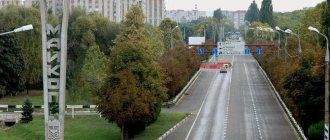- September 19, 2019
- Directions
- Molton
Obninsk is the first science city of our country. Where is Obninsk? This city is located in the north of the Kaluga region. Geographically, it is located on the European territory of Russia, on the Central Russian Upland, on the river. Protve (tributary of the Oka River). The city is located close to Moscow (80 km from the Moscow Ring Road). Distance to Kaluga – 68 km. The following cities are located in relative proximity: Tula, Bryansk, Smolensk. The number of inhabitants is 115,000 people.
Since the city is very close to Moscow, many people have a question: which region does Obninsk belong to? In fact, this is the Kaluga region, not the Moscow region.
General information and history of the city
To the question: “What can you say about your city?” Every resident of Obninsk will start with the fact that Obninsk is the first science city in Russia! Yes, this is what first of all made the young city famous.
View of the city
In 1911, on the territory of the future Obninsk, teacher Shchatsky founded a boarding school named after. Shchatsky S.T. “Vigorous Life”, on the site of which a secret facility of the USSR Ministry of Internal Affairs system was created called “Laboratory “B”” (the future Institute of Physics and Energy). The laboratory's activities were aimed at research in the field of nuclear physics; German scientists and the best Soviet specialists were invited for this purpose. As a result, the Obninsk Nuclear Power Plant was built - the world's first nuclear power plant, which was put into operation in June 1954.
This event brought world fame to the future city, which received official city status in 1956.
Obninsk NPP
In addition, ten more research institutes were built in Obninsk. Currently, Obninsk is a major scientific center and has the status of the first science city in Russia, which was officially awarded to the city in May 2000.
At the moment, Obninsk, with a territory of about 43 km2, is located in the north of the Kaluga region, 100 km from the capital in a southwestern direction along the M3 highway.
Obninsk attractions
There are not many historical monuments in Obninsk, but each of them is interesting and beautiful in its own way. Here is a small list of significant places that are clearly worth visiting at least once:
- Church of the Nativity;
- monument to the pioneers of nuclear energy;
- monument to Kurchatov;
- MIG-21 aircraft;
- sculpture “Scientist Cat”;
- estate "Bugry";
- Monument to Joliot-Curie;
- meteorological mast.
Climate and ecology of Obninsk, or “City in the Forest”
Obninsk is located in a temperate continental climate zone in a mixed forest, with cold snowy winters and warm humid summers. Autumn is moderately cool, the temperature in October is not lower than 5 ◦C.
Winter Obninsk
Spring is cold. She especially surprised residents in 2012. When all the snow on the streets had almost melted, heavy snowfall began on the night of April 5, which subsided only in the morning. Obninsk was literally covered with snow. The streets of Obninsk became impassable. Car owners had to dig their cars out of huge snowdrifts, and those who went out first had to work as bulldozers.
Obninsk from a bird's eye view
The air in the city is humid, about 76-78%, clean, despite the fact that on the outskirts, in the area of the old part of the city, there are sewage treatment plants, the impact of which is very rarely felt by residents of the area. The winds are also small, mainly the flow occurs on the two main streets of the city - Lenin Avenue and st. Kurchatov, which is due to their elongation. Naturally, the science city is not sparse in vegetation.
The Protva River (a tributary of the Oka) flows along the outskirts of the city, the cleanliness of which is not deplorable, but leaves much to be desired, but despite this, every summer the townspeople rush to swim and sunbathe at the local beach. Several ponds located in the city have the same condition.
View of the city from Belkinsky Park
Coat of arms
The coat of arms of Obninsk is presented in the form of a French shield. On an azure background, a bezant is depicted surrounded by four intertwined ellipse-shaped links. On the left and right sides it is accompanied by two laurel branches curved in the shape of a wreath. At the end there is a triple wavy thread-like belt. All figures are made in silver. The atom symbolizes the world's first nuclear power plant, and the three wavy lines symbolize the Protva River.
The artistic composition was adopted by decision of the Obninsk City Assembly No. 10-36 of June 29, 2005 (as amended on May 11, 2006) and entered into the State Heraldic Register of the Russian Federation under No. 1969.
Population of Obninsk
According to the latest estimates for 2014, the number of residents of Obninsk is 107.3 thousand people, which corresponds to 1/10 of the population of the Kaluga region.
It is the second largest city in the Kaluga region, after Kaluga. The pride of Obninsk are its honorary citizens. Among them are veterans of the Great Patriotic War (just under 400 people), public figures, scientists, sports and cultural workers. All of them made a significant contribution to the development of the city of Obninsk.
Veterans of the Great Patriotic War
The issue of local demographics, as throughout the country, remains unresolved. Over the past few years, the city has recorded a natural population decline (as of 2010, 1186 births and 1387 deaths, therefore, the natural population increase is 201; however, due to the fact that there are 376 more arrivals than departures, the total population increase is 175 people). .
Note that the number of Obninsk residents is still growing due to the fact that more than 1000 new citizens arrive in the city every year, and it is always higher than the rate of those leaving.
62% of the population are of working age. The average age of city residents is 38 years. There are 10% more women than men in percentage terms.
The share of students in daytime general education institutions accounts for about 15 thousand people in the population, which is 32% less than in 2000, and is due to a decrease in the birth rate during the years of perestroika.
The majority of the population are highly educated citizens. It’s not for nothing that Obninsk is the first science city in Russia. And all because the city has high scientific and technical potential (12 industry research institutes and a university).
Institute NRNU MEPhI
Most citizens take an active position in resolving city issues. Cleaning campaigns, beautification of the city, and helping those in need are often held, in which many participate to the delight.
Obninsk athletes are also not asleep. The city has a lot of sports clubs, several Olympic reserve schools, and the Olympus sports complex recently opened. Here such athletes as Nikolai Skvortsov (European champion, medalist of the world swimming championships), Mikhail Aloyan (world boxing champion), Alexey Egorov (European boxing champion) and many others grew up and continue their careers.
Districts and real estate of Obninsk
Map of the territorial division of the city of Obninsk
A small territory of the city is divided into districts, which are in turn divided into microdistricts, the number of which is fifty-two. It would be correct to begin describing the districts with the “father district” of the city, which stands unshakably, having seen many Obninsk residents in its, albeit short, lifetime. Residents of Obninsk call it Old Town.
It was from here that the construction of the city began. It does not leave anyone indifferent with its residential buildings in the style of the 18th-9th centuries, with their characteristic yellowish tints.
Typical residential building in the Old Town area
The area is quiet, there is no unnecessary fuss. In the old town there is a Park of Culture, where you can not only relax by the fountain, in a cozy summer cafe or while walking in the park, but also take your children with you, who will be interested in playing in the equipped children's playground, part of which can be seen in the photo below .
In general, Park Kultury has noticeably changed over the last 5 years. Apparently the city administration finally turned its attention to the fact that the child population needs this. And this can be said not only about the park; many courtyards miraculously began to surprise the townspeople with their equipped sports fields and playgrounds.
Children's playground in the Park of Culture
Real estate in this area is relatively inexpensive. Relatively, because the city is located not far from Moscow, so prices still make themselves felt. This applies to all areas of the city.
When entering the science city from Kaluga, you can see the small village of Obninskoye. Which consists mainly of small, private houses. The village is connected to the city by the railway station, which has undergone a significant transformation over the past few years.
Another village located on the territory of the city is Mirny. It is largely a residential area, as it is located on the outskirts of Obninsk. Housing there is inexpensive compared to other areas of the city, however, there are several dozen houses that are to be demolished. In their place, new 7- or 9-story buildings will be built, which will be the property of a Moscow company that has taken upon itself the responsibility for their construction. So, for example, in 51 microdistricts of the city, many houses were erected by the Moscow regional government. Therefore, living in this area costs citizens a little more.
Old house before demolition
Also in the area there is already a zone of modern multi-storey buildings, which is developing according to the planned scenario. In addition, 51 microdistricts cover Karl Marx Avenue, this is a busier part of the city.
The Triumph Plaza shopping and entertainment center built here does not go unnoticed. In the future it is planned that this area will be the center of the city. Probably due to the high concentration of trading activity in the area.
Shopping center Triumph Plaza
The current center of the city is the 39th district or Aksenov Square. You've probably already noticed that many city streets are named after famous scientific and cultural figures. Here is another, perhaps imaginary, but confirmation that Obninsk is a Science City. As in many cities of great Russia, people gather most of all near markets, shops, and entertainment centers, so it happened in this city.
In addition to the open market on the central square, there is a trading house under the same name Aksenovo, as well as several other shopping complexes. Near the square there is the central city library, a music school and an Orthodox church. This is the busiest area of the city.
All large-scale events, such as City Day, New Year's Eve with fireworks, and meetings with celebrities take place right here, on the central square.
Another concert on Aksenovskaya Square
27 microdistrict separated from the center by the Guryanovsky forest and another Obninsk attraction - a weather tower, but more on that later. This is also a busy part of the city, most of the local townspeople work at the , which once provided the skin for the Russian reusable shuttle for space flight, which far surpassed the American shuttle in quality. Typical “five- and nine-story buildings” filled almost the entire area. The courtyards are well equipped with playgrounds and playgrounds, schools, kindergartens, shops. The average residential area of Russian cities.
27 microdistrict
Well, a little about “Sunny Valley”. This area is still being built up, as can be seen in the picture. Now on this territory there are two villages - Olimpiyskaya and Belkino. However, they cannot be called villages; a more accurate name that would characterize them is modern cottage villages. One such house, shown in the photograph, costs about 3-4 million rubles.
Olimpic village
If you want to live near the capital, in a cozy, quiet, modern city, Obninsk is one of the best options.
This is what first made this young city famous.
2. Now Obninsk is a major scientific center, for its contribution to the development of science it has the status of the first science city in Russia, which was officially awarded to the city in May 2000.
3. Obninsk is located not far from Moscow, just 105 kilometers from the capital, in the very north of the Kaluga region.
4. This is the second largest city in the Kaluga region, after Kaluga.
5. For those who want to live near the capital, in a cozy, quiet, modern city, then Obninsk is one of the best options.
6. In 1911, on the territory of the future Obninsk, teacher Shchatsky founded a boarding school named after. Shchatsky S.T. "Cheerful life."
7. The history of Obninsk began with the creation immediately after the war, on the site of a boarding school, of a secret facility of the USSR Ministry of Internal Affairs called “Laboratory “B”,” in which research in the field of nuclear physics was carried out. For this purpose, German scientists and the best Soviet specialists were invited.
8.The laboratory grew into a physics and energy institute, the scientific town became a village, and the village became a city.
9. The Obninsk Nuclear Power Plant, the world’s first nuclear power plant, was built here, which was put into operation on June 26, 1954. This event brought world fame to the future city, which received official city status in 1956.
FIRST NPP IN OBNINSK
10. In 1954, only one channel uranium-graphite reactor with water coolant was equipped at the nuclear power plant. The reactor not only produced energy, but also served as a base for conducting a number of experiments.
11. The power plant operated for 48 years and was closed in 2002. Now here is the Museum of Atomic Energy, you can get into it by appointment together with a tour group and take a photo on the lid of a nuclear reactor.
12. The city has nothing to do with the Ob River. Obninsk received its name from the surnames of the nobles of Polish origin Obninsky, who bought villages and an estate here. The Obninskoye station was named after their surname. The station is still called that way, and the city was named Obninsk.
13. The whole history of the city is connected with science. No wonder his coat of arms depicts an atom. In Obninsk, the spirit of science, characteristic of science cities, is preserved. There are continuous research institutes, wide avenues and even formulas on the facades.
14. In addition to the first nuclear power plant in Obninsk, a “fast” reactor, a meteorological laboratory in the sky, and a training center for crews of nuclear submarines also started operating for the first time.
15.Here is the tallest meteorological mast in Europe - 310 meters. It is curious that it does not have a foundation, but stands on a huge ball and is supported by guy wires.
PHYSICAL AND ENERGY INSTITUTE IN OBNINSK
16. Also in the city there are 10 research institutes working in a variety of fields of knowledge.
17.Scientific “motives” are found everywhere in the city. Atom is the name of the entertainment center. On the façade of the former factory, Einstein’s formula is depicted, and one of the local stores is called “Radium” - they sell here, of course, not radioactive substances, but sports, music and office supplies.
18. Obninsk, strange as it may seem, can be called a city of submariners. Nuclear reactors for submarines were developed here, and a training center for submarine crews was created.
19. In Soviet times, because of secrecy, sailors wore green combined arms uniforms so that the enemy would not guess.
20. Also in Obninsk there is a monument to the nuclear submarine K-14.
21. Obninsk is also famous as a center of meteorology. The All-Russian Research Institute of Hydrometeorological Information, the Research Institute of Agricultural Meteorology and the Typhoon Research and Production Association are located in Obninsk.
ONE OF THE SYMBOLS OF THE CITY IS THE HIGH ALTITUDE METEOROLOGICAL MAST VMM-310
22. One of the symbols of the city is visible literally from everywhere - the high-altitude meteorological mast VMM-310. 310 meters is the height of the mast. It serves to accommodate meteorological equipment and study conditions at different altitudes.
23. Obninsk is also connected with aviation. The city is home to military pilots and aviation specialists.
24. During the war, the headquarters of the First Air Army, in which the famous Normandie-Niemen squadron fought, was stationed on the territory of Obninsk. A MiG-29 monument aircraft has been installed in the city.
25. In Obninsk there are several memorial places dedicated to the personality of the outstanding nuclear physicist Igor Vasilyevich Kurchatov, under whose leadership the first nuclear power plant was launched. The sculpture of the scientist is installed in the park near the Central Institute for Advanced Studies.
LENIN AVENUE
26. The longest street in Obninsk is Lenin Avenue, its length is more than 6 kilometers.
27.The city center is the 39th district or Aksenov Square. All large-scale events, such as City Day, New Year's Eve with fireworks, and meetings with celebrities take place right here, on the central square.
28. In addition to the market, on the central square there is a trading house under the same name Aksenovo, as well as several other shopping complexes. Near the square there is the central city library, a music school and an Orthodox church. This is the busiest area of the city.
29. Most of the city's population are highly educated citizens. It’s not for nothing that Obninsk is the first science city in Russia. And all because the city has high scientific and technical potential (12 industry research institutes and a university).
30. The city's transport infrastructure is in good condition. In addition to shuttle buses, there are many Gazelle minibuses that don’t make you wait long at stops. There is also the availability and low cost of passenger taxis that will take passengers to any part of the city.
31. In 2006, a technology park was built on the outskirts of the city, which houses several huge industrial enterprises, including even nanotechnology.
32. In addition, the city has a developed trade industry, a large number of shopping and entertainment centers and complexes where you can find everything your heart desires and have a great rest. Not to mention the numerous trading houses and supermarkets.
33. Obninsk is the only city in the world where the avenue diverges in three directions.
ETERNAL FLAME
34. In the center of Obninsk on Victory Square, near the Eternal Flame, a light and music fountain has been opened - jets of water shimmer in different colors and “dance” to the beat of the melodies. The fountain looks especially impressive in the evening.
35. The pride of Obninsk are its honorary citizens. Among them are veterans of the Great Patriotic War (just under 400 people), public figures, scientists, sports and cultural workers. All of them made a significant contribution to the development of the city of Obninsk.
MONUMENT TO NUCLEAR FIELDERS - PIONEERS IN OBNINSK
36. The number of city residents is growing due to the fact that more than 1000 new citizens arrive in Obninsk annually, and this is higher than the rate of those leaving.
37. There are a lot of attractions in Obninsk, these are all kinds of monuments, memorials, plaques in honor of famous literary and scientific figures, etc. Also, many city streets are named after famous scientific and cultural figures.
CITY HISTORY MUSEUM
38. Anyone who wants to learn more about Obninsk should visit the Museum of the History of the City. The museum's collection contains about 60 thousand exhibits. Here are presented ancient tools, weapons and pottery, religious objects found during excavations near the city; costumes of peasants of the surrounding villages of the late 19th century.
39. Most of the exhibition is dedicated to the events of the twentieth century - the opening of the city's research institutes, the creation of the first nuclear power plant, and there is also a lot of material about outstanding Russian scientists who worked in Obninsk.
40. The small territory of the city is divided into districts, which are in turn divided into microdistricts in the amount of 52. The main district of the city, which stands unshakably, having seen many Obninsk residents in its, albeit short, lifetime. Residents of Obninsk call it Old Town.
41.It was with him that the construction of the city began. It does not leave anyone indifferent with its residential buildings in the style of the 18th and 19th centuries, with a characteristic yellowish tint.
42. This area is quiet, there is no unnecessary fuss here. In the Old Town there is a Park of Culture, where you can not only relax by the fountain, in a cozy summer cafe or while walking in the park, but also take your children with you, they will have fun playing in the equipped playground.
PROTVA RIVER ON THE OUTSIDE OF THE CITY
43. On the outskirts of the city, the Protva River flows, a tributary of the Oka, the cleanliness of which leaves much to be desired, but despite this, the townspeople swim and sunbathe on the local beach every summer. There are also several ponds in the city.
44. Although Obninsk is called a science city, considerable efforts by the administration were made for the industrial development of the city. Agreements were concluded with foreign companies. Large (even all-Russian and world-wide) industrial enterprises were built.
BUST A.S. PUSHKIN IN BELKINSKY PARK
45. The main economic areas are the food industry, which includes the production of sausages, dairy and alcoholic beverages.
46. Construction industry - metal and reinforced concrete structures, plywood products, etc.; also instrument-making, this primarily includes the production of computer equipment, military equipment, equipment for nuclear power plants and others. Chemical and pharmacological industries for the production of auto chemicals, polymer pipes, pharmaceutical products and much more.
OLD WATER TOWER
47. Another landmark of the city is the old water tower in the Old Town, the demolition of which and use for commercial purposes is prohibited.
48. Another distinctive feature of the city was the suspension bridge that connects the Old City with the village of Mirny. It was built in 1961 and has always attracted locals, but it closed in 2007.
BELKINSKIE POND IN OBNINSK
49. In the north-west of Obninsk there is a beautiful Belkinsky park, where you can explore the estate landscape of the 18th century. Walking through the park, here you can see a gazebo for lovers, a pond, centuries-old willows, bridges, the current Church of Boris and Gleb built in 1773 in the Baroque style and, unfortunately, the ruins of the former Belkino estate.
50. Once upon a time there was an estate of the Vorontsovs, in which Pushkin, Levitan, and Serov lived.
photo from public domain
City infrastructure
Throughout Russia, the issue of fools and roads, and fools on the roads, still remains unresolved. And although not only roadways, but also pedestrian sidewalks, and even in courtyards, are repaired here very often and in large quantities, there is still a problem with the road surface, probably after the famous Russian winter, after which these holes and potholes appear on the roads .
This cannot be said about all the streets of the city. Naturally, the central streets of the city have a neat appearance in this regard, although sometimes you can stumble upon small holes there. What can we say about secondary alleys and courtyards? Here, of course, things are worse.
The city's transport infrastructure is in the best condition. In addition to shuttle buses, there are many Gazelle minibuses that don’t make you wait long at stops. Also pleasing is the availability and low cost of passenger taxis that will take you to any part of the city.
The number of car owners is also not small; in every yard you will see cars standing by the sidewalk or on the sidewalk, waiting for their owners. The problem is that there are few equipped parking spaces in the courtyards.
It is no longer profitable for lazy car owners to go to a paid parking lot, leave the car there and return home on foot. However, despite such a large number of vehicles and in some places the road condition is not the best, traffic in the city is relatively free. Congestion, and moreover, traffic jams, occurs very rarely, thanks to the breadth of the central streets and parking spaces equipped on them, and of course, well-organized traffic regulation.
The city's housing and communal services are also different in different areas. In areas 27, 51 and central, the situation is slightly better than in the area of the old city and two villages. For the latter, the problems with public utilities are that many houses that are subject to demolition in the near future, according to the city administration’s plan, which is already being implemented, although not quickly, need major repairs, and therefore they are not paid much attention to , which the residents, of course, do not like, because it may take a long time to wait until they are moved to the new houses that they are promised.
House to be demolished
Note also that even they never have problems with power outages or water supply. Emergency shutdowns happen very rarely here, I don’t remember the last time it happened. The rent, for example, in such houses is from 3 to 6 thousand rubles. In busier parts of the city, prices are naturally higher.
The city administration needs to work much more effectively to improve the cleanliness of the streets. You can often find filled garbage cans on city streets, and even scraps lie around the trash can. For this reason, local organizations often try to organize “subbotniks” and restore order in their hometown on their own. Where would we be without them? Fortunately, people respond to the request for help.
Cleanup day in Obninsk
Another problem of the city is kindergartens. To register their child there, young mothers have to wait in line even before the baby is born, which creates quite a few problems for the young family. However, when your student has grown to school age, you will not have any problems placing him in a secondary school or a specialized lyceum, where he can gain great knowledge. Once again, it is not for nothing that our city is called a science city.
Lyceum "Derzhava"
Enterprises and work in Obninsk
Although Obninsk is called a science city, considerable efforts of the administration were spent on the industrial development of the city. Agreements were concluded with foreign companies. Large (even all-Russian and world-wide) industrial enterprises were built.
The main economic areas are the food industry, which includes the production of sausages, dairy and alcoholic beverages; construction industry – metal and reinforced concrete structures, plywood products, etc.; also instrument-making, this primarily includes the production of computer equipment, military equipment, equipment for nuclear power plants, etc.; chemical and pharmacological industries for the production of auto chemicals, polymer pipes, pharmaceutical products and much more.
Samsung Factory
In 2006, a technology park was built on the outskirts of the city, which houses several huge industrial enterprises, including even nanotechnology. In addition, the city has a developed trade industry, a large number of shopping and entertainment centers and complexes, where you can find everything your heart desires and have a great rest. And we're not talking about the numerous trading houses and supermarkets.
There is a job for everyone in the city, they don’t seem to complain about it here, the salaries are quite good, of course, this is an elastic concept, it varies in different areas. In the employment center there are mostly low-paid jobs, however, at bus stops you can often find advertisements with salaries starting from 25 thousand rubles. Basically it is. Working conditions are, of course, different everywhere; it is impossible to say generally about all of them, citing one enterprise as an example. However, the good news is that there are a considerable number of enterprises with excellent working conditions.
Some organizations even encourage and encourage part-time work for students. An example is Home Credit & Finance bank. But this is far from the limit. According to statistics, the average salary of city residents is 21,000 rubles. And the official unemployment rate is 0.52%. Not bad. But don’t delude yourself, these are only official statistics.
Employment
Obninsk is a city of large high-tech enterprises. They produce equipment and instruments, including for nuclear power plants. The production of medicines, polymer products, auto chemicals, computer equipment, and metal structures has been established. The food industry is very developed here. Some Obninsk enterprises have world status.
Apparently, there are no problems with employment in the city. Here you can find a good job for every taste. Salaries, of course, are higher than the national average. Both the special status of the city and its proximity to the Russian capital have an impact. Official statistics show very low unemployment figures and good salaries. To believe her or not is up to each individual.
Crime
If you read the crime chronicle of Obninsk in a newspaper or on the Internet, you will see that most crimes are thefts. They make up more than half, or rather about 70% of all crimes. This is the theft of money on the street, mobile phones, bags, there are also counterfeit bills, most often in denominations of 1000 rubles.
Fights and drunkenness, theft of cars or their contents are a little less common, although they are stolen no more often than bicycles; you can also see notes about burglaries, which have become much less frequent lately. Articles about crimes against human life and health are published even less frequently.
There were no particularly pronounced oddities in the history of Obninsk, perhaps only in 2006, the rape and murder of a young girl of about 25, by a security guard at the store where she worked, in the area of the old city, after she was returning from a night shift. But this is an isolated case. Moreover, if you believe the media, more than half of all crimes were solved, including about 40% without delay. We must pay tribute to the employees of the Department of Internal Affairs, who do not sleep at their posts. And sometimes they carry out operational preventive operations, during which weekly raids are carried out to protect public order and ensure security, and operations to work with teenagers. All these events are going well.
In general terms, we can say that city residents do not have to fear for their lives and property, but still be on guard. Life is given by God and should be appreciated!
